Examining Trump's 2016 Victory: Immigration and Group Status Threat
VerifiedAdded on 2022/09/24
|12
|3502
|16
Report
AI Summary
This research paper examines the factors contributing to Donald Trump's victory in the 2016 presidential election, with a focus on immigration, group status threat, and the concept of whiteness. The paper begins by defining group status threat and whiteness, arguing that white Americans' fear of losing social standing and their perceived diminishing ability to exercise their whiteness were significant drivers of Trump's success. It then analyzes four key events in American history—the 9/11 attacks, the 2008 financial crisis, outsourcing, and work automation—as factors that intensified these anxieties. The paper also examines Trump's campaign strategy, particularly his use of anti-immigrant rhetoric and appeals to white identity. Drawing on the work of scholars like Brenda Major and Ta-Nehisi Coates, the report highlights how Trump's messaging resonated with white voters concerned about demographic shifts and economic anxieties. The analysis includes a discussion of how globalization and automation have impacted the economic standing of working-class whites, and how Trump's campaign effectively capitalized on these concerns to secure electoral victory. The paper concludes by summarizing the interwoven categories of diversity, economy, and the use of whiteness, as the main drivers of Trump's victory.
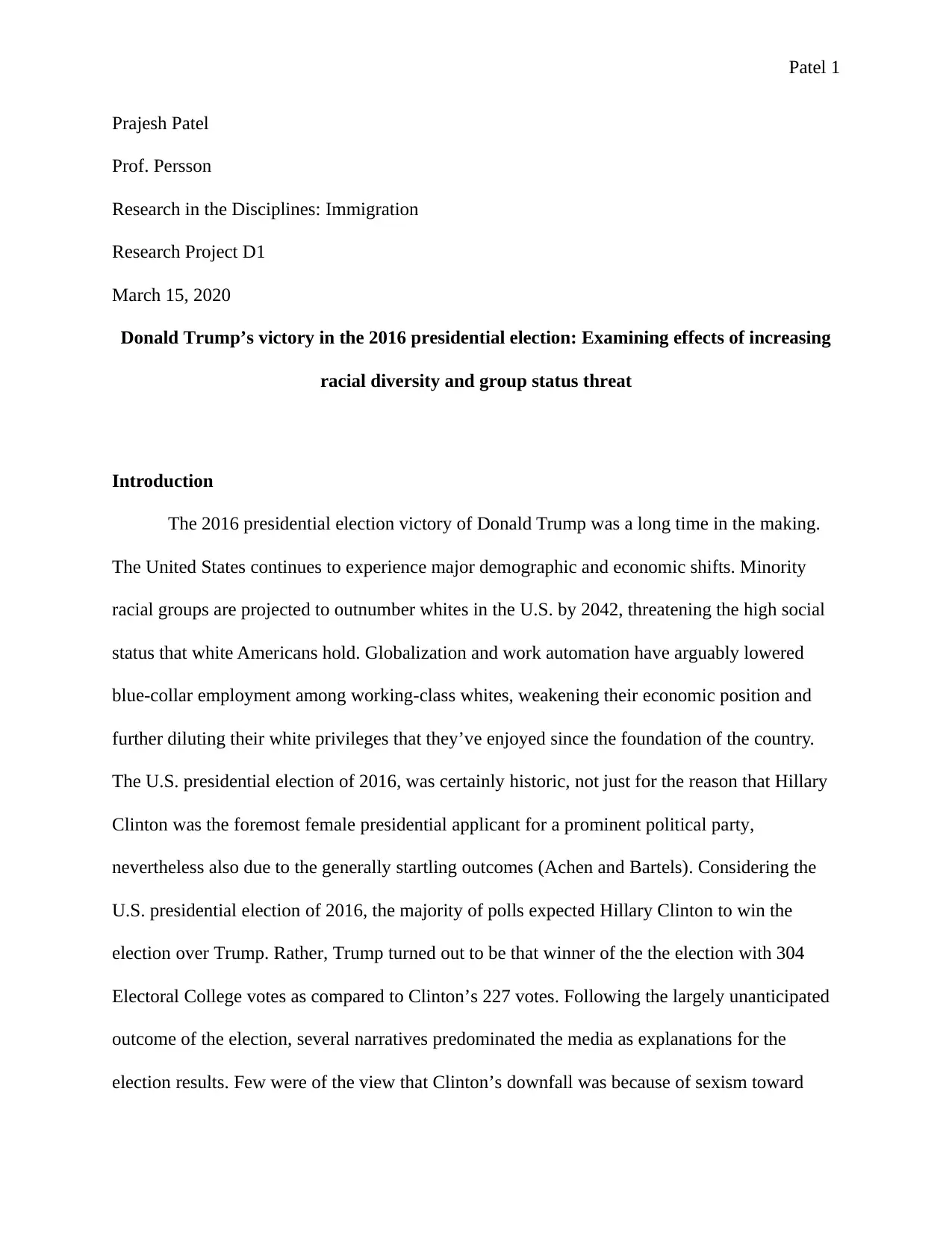
Patel 1
Prajesh Patel
Prof. Persson
Research in the Disciplines: Immigration
Research Project D1
March 15, 2020
Donald Trump’s victory in the 2016 presidential election: Examining effects of increasing
racial diversity and group status threat
Introduction
The 2016 presidential election victory of Donald Trump was a long time in the making.
The United States continues to experience major demographic and economic shifts. Minority
racial groups are projected to outnumber whites in the U.S. by 2042, threatening the high social
status that white Americans hold. Globalization and work automation have arguably lowered
blue-collar employment among working-class whites, weakening their economic position and
further diluting their white privileges that they’ve enjoyed since the foundation of the country.
The U.S. presidential election of 2016, was certainly historic, not just for the reason that Hillary
Clinton was the foremost female presidential applicant for a prominent political party,
nevertheless also due to the generally startling outcomes (Achen and Bartels). Considering the
U.S. presidential election of 2016, the majority of polls expected Hillary Clinton to win the
election over Trump. Rather, Trump turned out to be that winner of the the election with 304
Electoral College votes as compared to Clinton’s 227 votes. Following the largely unanticipated
outcome of the election, several narratives predominated the media as explanations for the
election results. Few were of the view that Clinton’s downfall was because of sexism toward
Prajesh Patel
Prof. Persson
Research in the Disciplines: Immigration
Research Project D1
March 15, 2020
Donald Trump’s victory in the 2016 presidential election: Examining effects of increasing
racial diversity and group status threat
Introduction
The 2016 presidential election victory of Donald Trump was a long time in the making.
The United States continues to experience major demographic and economic shifts. Minority
racial groups are projected to outnumber whites in the U.S. by 2042, threatening the high social
status that white Americans hold. Globalization and work automation have arguably lowered
blue-collar employment among working-class whites, weakening their economic position and
further diluting their white privileges that they’ve enjoyed since the foundation of the country.
The U.S. presidential election of 2016, was certainly historic, not just for the reason that Hillary
Clinton was the foremost female presidential applicant for a prominent political party,
nevertheless also due to the generally startling outcomes (Achen and Bartels). Considering the
U.S. presidential election of 2016, the majority of polls expected Hillary Clinton to win the
election over Trump. Rather, Trump turned out to be that winner of the the election with 304
Electoral College votes as compared to Clinton’s 227 votes. Following the largely unanticipated
outcome of the election, several narratives predominated the media as explanations for the
election results. Few were of the view that Clinton’s downfall was because of sexism toward
Paraphrase This Document
Need a fresh take? Get an instant paraphrase of this document with our AI Paraphraser
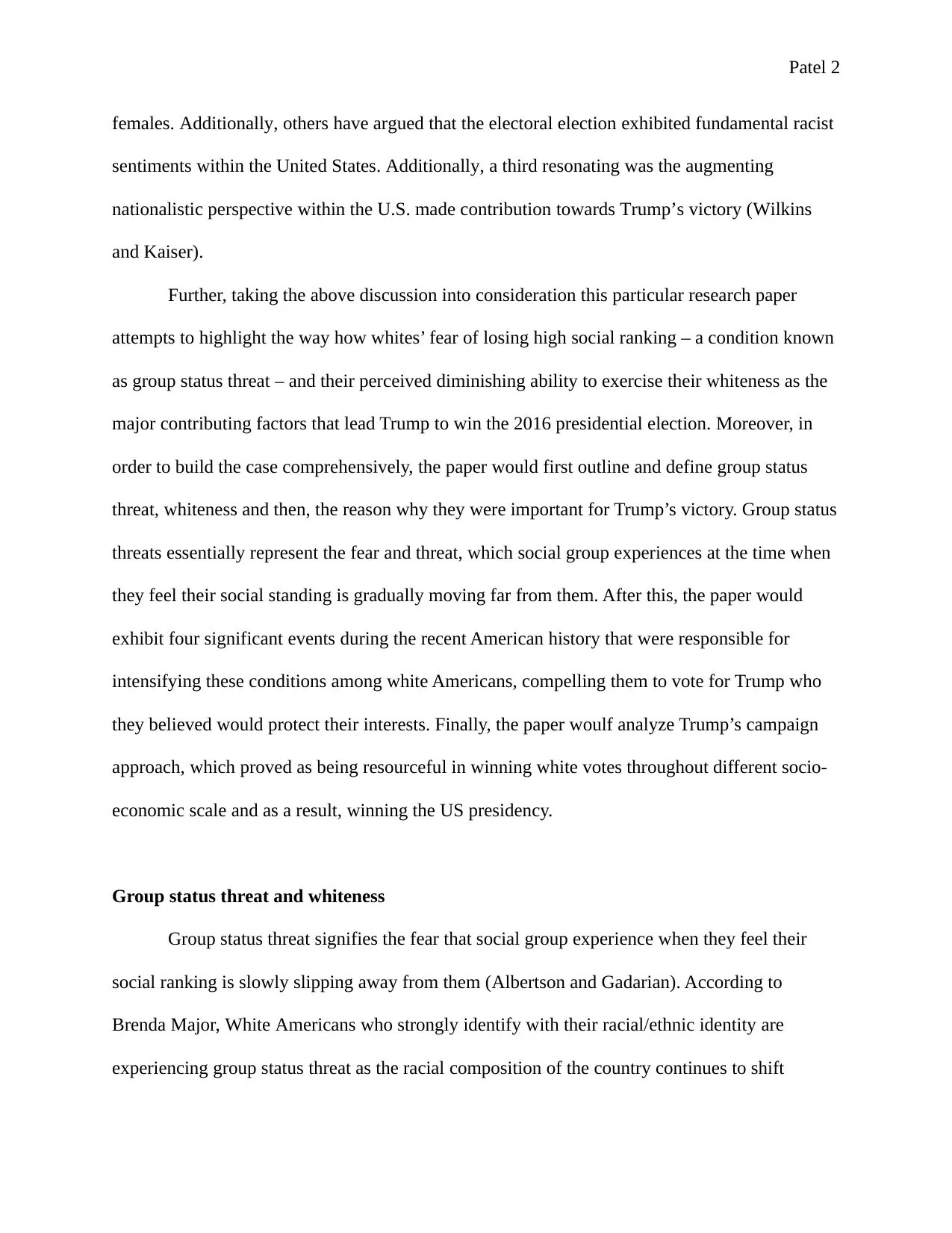
Patel 2
females. Additionally, others have argued that the electoral election exhibited fundamental racist
sentiments within the United States. Additionally, a third resonating was the augmenting
nationalistic perspective within the U.S. made contribution towards Trump’s victory (Wilkins
and Kaiser).
Further, taking the above discussion into consideration this particular research paper
attempts to highlight the way how whites’ fear of losing high social ranking – a condition known
as group status threat – and their perceived diminishing ability to exercise their whiteness as the
major contributing factors that lead Trump to win the 2016 presidential election. Moreover, in
order to build the case comprehensively, the paper would first outline and define group status
threat, whiteness and then, the reason why they were important for Trump’s victory. Group status
threats essentially represent the fear and threat, which social group experiences at the time when
they feel their social standing is gradually moving far from them. After this, the paper would
exhibit four significant events during the recent American history that were responsible for
intensifying these conditions among white Americans, compelling them to vote for Trump who
they believed would protect their interests. Finally, the paper woulf analyze Trump’s campaign
approach, which proved as being resourceful in winning white votes throughout different socio-
economic scale and as a result, winning the US presidency.
Group status threat and whiteness
Group status threat signifies the fear that social group experience when they feel their
social ranking is slowly slipping away from them (Albertson and Gadarian). According to
Brenda Major, White Americans who strongly identify with their racial/ethnic identity are
experiencing group status threat as the racial composition of the country continues to shift
females. Additionally, others have argued that the electoral election exhibited fundamental racist
sentiments within the United States. Additionally, a third resonating was the augmenting
nationalistic perspective within the U.S. made contribution towards Trump’s victory (Wilkins
and Kaiser).
Further, taking the above discussion into consideration this particular research paper
attempts to highlight the way how whites’ fear of losing high social ranking – a condition known
as group status threat – and their perceived diminishing ability to exercise their whiteness as the
major contributing factors that lead Trump to win the 2016 presidential election. Moreover, in
order to build the case comprehensively, the paper would first outline and define group status
threat, whiteness and then, the reason why they were important for Trump’s victory. Group status
threats essentially represent the fear and threat, which social group experiences at the time when
they feel their social standing is gradually moving far from them. After this, the paper would
exhibit four significant events during the recent American history that were responsible for
intensifying these conditions among white Americans, compelling them to vote for Trump who
they believed would protect their interests. Finally, the paper woulf analyze Trump’s campaign
approach, which proved as being resourceful in winning white votes throughout different socio-
economic scale and as a result, winning the US presidency.
Group status threat and whiteness
Group status threat signifies the fear that social group experience when they feel their
social ranking is slowly slipping away from them (Albertson and Gadarian). According to
Brenda Major, White Americans who strongly identify with their racial/ethnic identity are
experiencing group status threat as the racial composition of the country continues to shift

Patel 3
towards a non-white majority. This discontentment, Major argues, led them to endorse
conservative, nationalist political positions, benefiting Trump who they felt offered the best hope
to protect their social status in the society.
Major conducted a social psychology study comprising 376 White Americans–262
Democrats and 114 Republicans. The findings demonstrated that whites with a strong sense of
ethnic identity feared losing social status in the society to other racial groups. This condition,
known as group status threat, led many to support Trump who adopted anti-immigrant and anti-
diversity rhetoric. The participants were randomly assigned to read one of two press releases.
One press release contained what Major called a “racial shift condition” which indicated that
racial minorities will outnumber whites in the U.S. by 2042; the other did not contain such
language. Whites high in ethnic identification reported greater group status threat, higher
likelihood of voting for Trump, and more accepting of anti-immigrant policies. Major assessed
that Trump’s strong opposition to “outsiders” such as Muslims and illegal immigrants from Latin
America appeared to gravitate White Americans high in racial/ethnic identification who were
concerned about their declining position in American society.
Whiteness is a privilege, resulting from prominent social status. Ta-Nehisi Coates
cryptically defines whiteness as "ancestral talisman" and that “bloody heirloom” which cannot
ensure mastery of all events but can conjure a tailwind for most of them. While past presidents
have invoked whiteness in more subtle ways, Trump exploited it the extreme, driving up the
numbers among White voters. Coates posits that Trump would not be president were it not for
his whiteness. While Trump’s predecessors used the power of whiteness passively, he made it an
explicit, central part of his identity. Coats highlights Trump’s disdain for Blacks, and a black
president, citing the birther issue he raised to suggest that President Obama was not born in the
towards a non-white majority. This discontentment, Major argues, led them to endorse
conservative, nationalist political positions, benefiting Trump who they felt offered the best hope
to protect their social status in the society.
Major conducted a social psychology study comprising 376 White Americans–262
Democrats and 114 Republicans. The findings demonstrated that whites with a strong sense of
ethnic identity feared losing social status in the society to other racial groups. This condition,
known as group status threat, led many to support Trump who adopted anti-immigrant and anti-
diversity rhetoric. The participants were randomly assigned to read one of two press releases.
One press release contained what Major called a “racial shift condition” which indicated that
racial minorities will outnumber whites in the U.S. by 2042; the other did not contain such
language. Whites high in ethnic identification reported greater group status threat, higher
likelihood of voting for Trump, and more accepting of anti-immigrant policies. Major assessed
that Trump’s strong opposition to “outsiders” such as Muslims and illegal immigrants from Latin
America appeared to gravitate White Americans high in racial/ethnic identification who were
concerned about their declining position in American society.
Whiteness is a privilege, resulting from prominent social status. Ta-Nehisi Coates
cryptically defines whiteness as "ancestral talisman" and that “bloody heirloom” which cannot
ensure mastery of all events but can conjure a tailwind for most of them. While past presidents
have invoked whiteness in more subtle ways, Trump exploited it the extreme, driving up the
numbers among White voters. Coates posits that Trump would not be president were it not for
his whiteness. While Trump’s predecessors used the power of whiteness passively, he made it an
explicit, central part of his identity. Coats highlights Trump’s disdain for Blacks, and a black
president, citing the birther issue he raised to suggest that President Obama was not born in the
⊘ This is a preview!⊘
Do you want full access?
Subscribe today to unlock all pages.

Trusted by 1+ million students worldwide
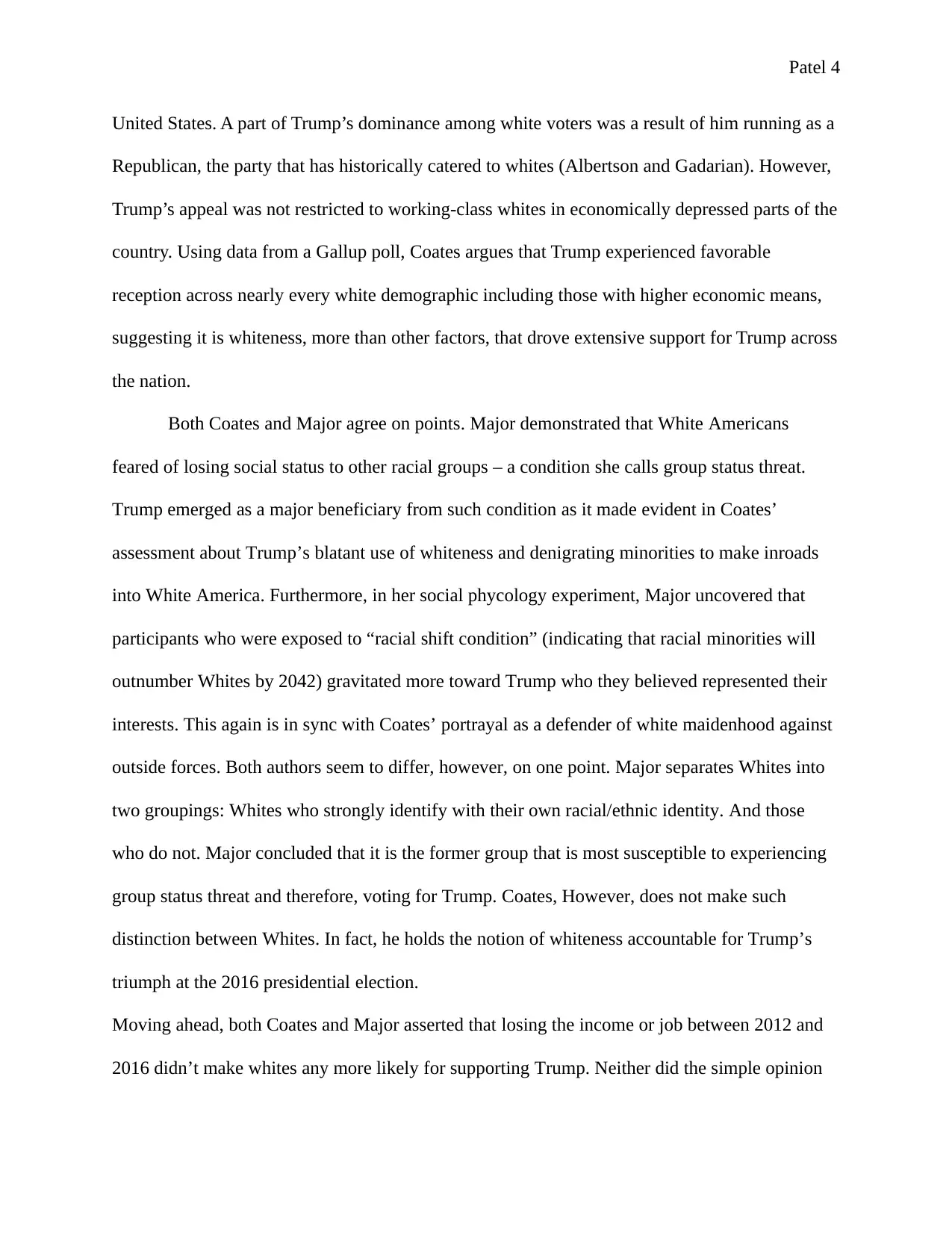
Patel 4
United States. A part of Trump’s dominance among white voters was a result of him running as a
Republican, the party that has historically catered to whites (Albertson and Gadarian). However,
Trump’s appeal was not restricted to working-class whites in economically depressed parts of the
country. Using data from a Gallup poll, Coates argues that Trump experienced favorable
reception across nearly every white demographic including those with higher economic means,
suggesting it is whiteness, more than other factors, that drove extensive support for Trump across
the nation.
Both Coates and Major agree on points. Major demonstrated that White Americans
feared of losing social status to other racial groups – a condition she calls group status threat.
Trump emerged as a major beneficiary from such condition as it made evident in Coates’
assessment about Trump’s blatant use of whiteness and denigrating minorities to make inroads
into White America. Furthermore, in her social phycology experiment, Major uncovered that
participants who were exposed to “racial shift condition” (indicating that racial minorities will
outnumber Whites by 2042) gravitated more toward Trump who they believed represented their
interests. This again is in sync with Coates’ portrayal as a defender of white maidenhood against
outside forces. Both authors seem to differ, however, on one point. Major separates Whites into
two groupings: Whites who strongly identify with their own racial/ethnic identity. And those
who do not. Major concluded that it is the former group that is most susceptible to experiencing
group status threat and therefore, voting for Trump. Coates, However, does not make such
distinction between Whites. In fact, he holds the notion of whiteness accountable for Trump’s
triumph at the 2016 presidential election.
Moving ahead, both Coates and Major asserted that losing the income or job between 2012 and
2016 didn’t make whites any more likely for supporting Trump. Neither did the simple opinion
United States. A part of Trump’s dominance among white voters was a result of him running as a
Republican, the party that has historically catered to whites (Albertson and Gadarian). However,
Trump’s appeal was not restricted to working-class whites in economically depressed parts of the
country. Using data from a Gallup poll, Coates argues that Trump experienced favorable
reception across nearly every white demographic including those with higher economic means,
suggesting it is whiteness, more than other factors, that drove extensive support for Trump across
the nation.
Both Coates and Major agree on points. Major demonstrated that White Americans
feared of losing social status to other racial groups – a condition she calls group status threat.
Trump emerged as a major beneficiary from such condition as it made evident in Coates’
assessment about Trump’s blatant use of whiteness and denigrating minorities to make inroads
into White America. Furthermore, in her social phycology experiment, Major uncovered that
participants who were exposed to “racial shift condition” (indicating that racial minorities will
outnumber Whites by 2042) gravitated more toward Trump who they believed represented their
interests. This again is in sync with Coates’ portrayal as a defender of white maidenhood against
outside forces. Both authors seem to differ, however, on one point. Major separates Whites into
two groupings: Whites who strongly identify with their own racial/ethnic identity. And those
who do not. Major concluded that it is the former group that is most susceptible to experiencing
group status threat and therefore, voting for Trump. Coates, However, does not make such
distinction between Whites. In fact, he holds the notion of whiteness accountable for Trump’s
triumph at the 2016 presidential election.
Moving ahead, both Coates and Major asserted that losing the income or job between 2012 and
2016 didn’t make whites any more likely for supporting Trump. Neither did the simple opinion
Paraphrase This Document
Need a fresh take? Get an instant paraphrase of this document with our AI Paraphraser

Patel 5
that one’s financial condition had declined. An individual’s outlook on the way how trade
impacted individual finances had less impact upon political preferences. And, nor did joblessness
or the level of production jobs within one’s area. While economic anxiety didn’t highlight
Trump’s appeal, Coates and Major discovered reason rather to credit white people whose
thinking modified in manners, which mirrored an increasing sense of global or racial threat.
Taking a step ahead, both Coates and Major believe that during the year 2012, voters observed
less disparity between themselves as well as the applicants on trade. However, by the year 2016,
the voters had shifted somewhat right, as they believed that Trump as shifting towards far right,
while Clinton had shifted towards the left (Lenz). Thus, the white voters, in a self-justifying
crouch, observed themselves as being closer to Trump. In addition, on the threat that was posed
through China, voters barely shifted between the year 2012 and 2016, however while they
observed both presidential applicants as being towards their left during the year 2012, they
discovered Trump as having shifted just towards their right by the year 2016, again positioning
them nearer to the Republican applicant as compared to the Democratic one. The findings of
Coates and Major, point toward a threat that American worldwide dominance was under threat
danger, a perception, which benefited Trump as well as the Republican Party.
Intensification of group status threat and whiteness
In this section, I will discuss, with case studies, four significant events that heightened whites’
fear of losing social grip. The 9/11 attacks, the significant downturn experienced in 2008 as a
result of real estate market crash, outsourcing and its effects on Americans’ ability to find high-
paying jobs. The 9/11 attacks and downturn experienced during the year resulted in a sense of
threat among the white Americans that they would lose their position and dominance. And work
that one’s financial condition had declined. An individual’s outlook on the way how trade
impacted individual finances had less impact upon political preferences. And, nor did joblessness
or the level of production jobs within one’s area. While economic anxiety didn’t highlight
Trump’s appeal, Coates and Major discovered reason rather to credit white people whose
thinking modified in manners, which mirrored an increasing sense of global or racial threat.
Taking a step ahead, both Coates and Major believe that during the year 2012, voters observed
less disparity between themselves as well as the applicants on trade. However, by the year 2016,
the voters had shifted somewhat right, as they believed that Trump as shifting towards far right,
while Clinton had shifted towards the left (Lenz). Thus, the white voters, in a self-justifying
crouch, observed themselves as being closer to Trump. In addition, on the threat that was posed
through China, voters barely shifted between the year 2012 and 2016, however while they
observed both presidential applicants as being towards their left during the year 2012, they
discovered Trump as having shifted just towards their right by the year 2016, again positioning
them nearer to the Republican applicant as compared to the Democratic one. The findings of
Coates and Major, point toward a threat that American worldwide dominance was under threat
danger, a perception, which benefited Trump as well as the Republican Party.
Intensification of group status threat and whiteness
In this section, I will discuss, with case studies, four significant events that heightened whites’
fear of losing social grip. The 9/11 attacks, the significant downturn experienced in 2008 as a
result of real estate market crash, outsourcing and its effects on Americans’ ability to find high-
paying jobs. The 9/11 attacks and downturn experienced during the year resulted in a sense of
threat among the white Americans that they would lose their position and dominance. And work

Patel 6
automation that continues to replace manual labor, putting economic pressure on blue-collar
Americans. It is actually the group threat, which has greatly motivated Trump supporters. Two
types of group status threats are particularly prevalent within the US even today. For the
foremost time ever since when Europeans came to this nation, white Americans are being
informed about the fact that they would very become a minority race. Additionally, the
decreasing share of the white of the national populace is unexpected to modify status of white
Americans being the highly economically prominent racial group, however symbolically; it
threatens few whites’ perspective of power over political and social preferences. Moving ahead,
at the time when confronted with substantiation of racial advancement, whites feel threatened as
well as come across decreased degree of self-worth in contrast to the control group. Further, they
also observed higher anti-white bias as way of gaining back the lost feelings of self-importance.
Secondly, white Americans felt threatened through the rising reliance of the US upon other
nations. As latest headlines have highlighted, the period of American worldwide control has
finished. Whether these headlines are applicable continues to be an area of high debate, however
the view of a threat towards US worldwide dominance is quite real (Lenz). For instance, during
the year 2011, around 38 percent of Americans were of the view that the United States stands
above all other nations around the globe; by the year 2014, this same amount was decreased to
around 28 percent. Such decline has been observed as being the highly precipitous amongst the
Republicans (Lenz). Furthermore, the “China threat” in specific looms greatly among several
white American minds.
Trump’s Campaign Strategy
automation that continues to replace manual labor, putting economic pressure on blue-collar
Americans. It is actually the group threat, which has greatly motivated Trump supporters. Two
types of group status threats are particularly prevalent within the US even today. For the
foremost time ever since when Europeans came to this nation, white Americans are being
informed about the fact that they would very become a minority race. Additionally, the
decreasing share of the white of the national populace is unexpected to modify status of white
Americans being the highly economically prominent racial group, however symbolically; it
threatens few whites’ perspective of power over political and social preferences. Moving ahead,
at the time when confronted with substantiation of racial advancement, whites feel threatened as
well as come across decreased degree of self-worth in contrast to the control group. Further, they
also observed higher anti-white bias as way of gaining back the lost feelings of self-importance.
Secondly, white Americans felt threatened through the rising reliance of the US upon other
nations. As latest headlines have highlighted, the period of American worldwide control has
finished. Whether these headlines are applicable continues to be an area of high debate, however
the view of a threat towards US worldwide dominance is quite real (Lenz). For instance, during
the year 2011, around 38 percent of Americans were of the view that the United States stands
above all other nations around the globe; by the year 2014, this same amount was decreased to
around 28 percent. Such decline has been observed as being the highly precipitous amongst the
Republicans (Lenz). Furthermore, the “China threat” in specific looms greatly among several
white American minds.
Trump’s Campaign Strategy
⊘ This is a preview!⊘
Do you want full access?
Subscribe today to unlock all pages.

Trusted by 1+ million students worldwide
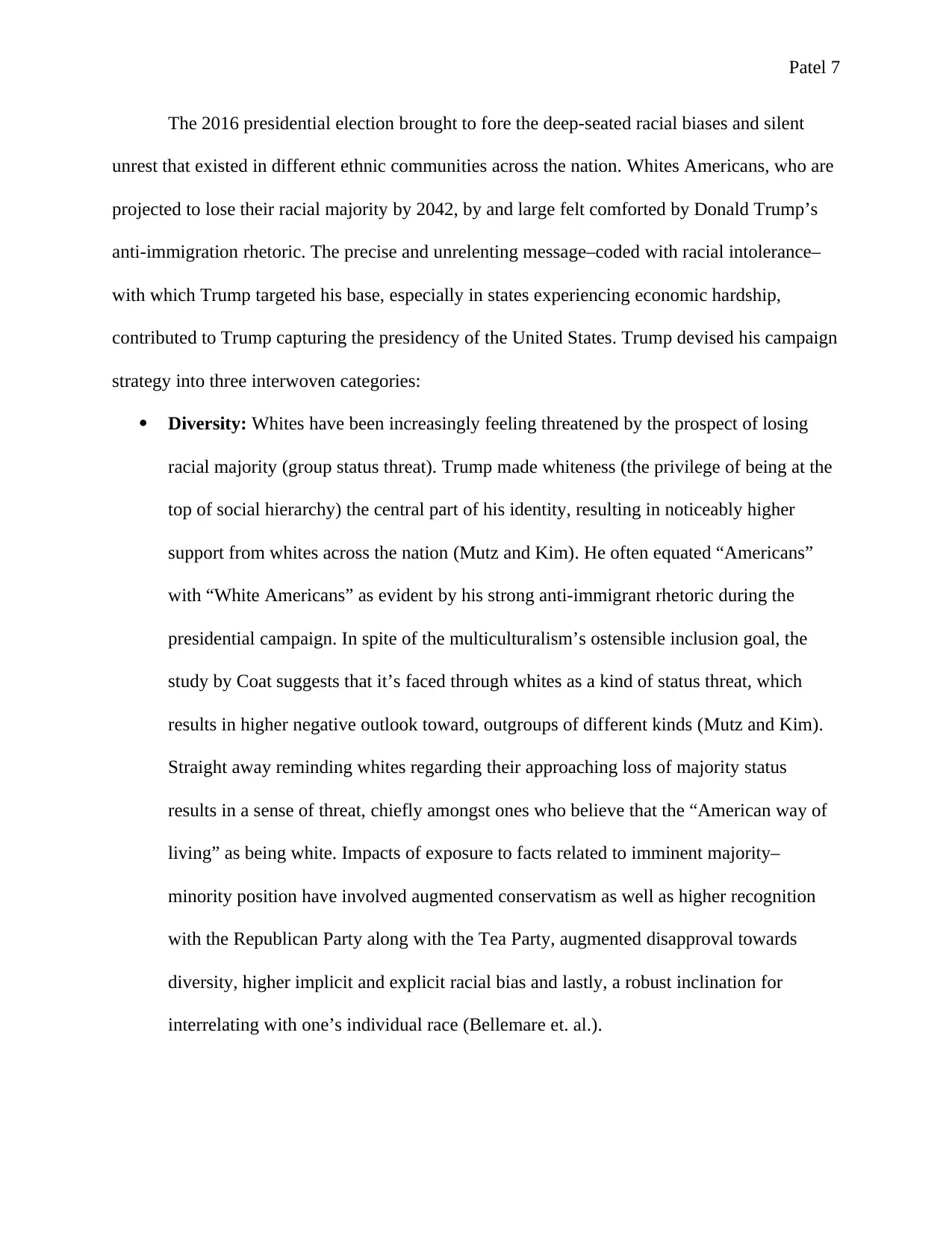
Patel 7
The 2016 presidential election brought to fore the deep-seated racial biases and silent
unrest that existed in different ethnic communities across the nation. Whites Americans, who are
projected to lose their racial majority by 2042, by and large felt comforted by Donald Trump’s
anti-immigration rhetoric. The precise and unrelenting message–coded with racial intolerance–
with which Trump targeted his base, especially in states experiencing economic hardship,
contributed to Trump capturing the presidency of the United States. Trump devised his campaign
strategy into three interwoven categories:
Diversity: Whites have been increasingly feeling threatened by the prospect of losing
racial majority (group status threat). Trump made whiteness (the privilege of being at the
top of social hierarchy) the central part of his identity, resulting in noticeably higher
support from whites across the nation (Mutz and Kim). He often equated “Americans”
with “White Americans” as evident by his strong anti-immigrant rhetoric during the
presidential campaign. In spite of the multiculturalism’s ostensible inclusion goal, the
study by Coat suggests that it’s faced through whites as a kind of status threat, which
results in higher negative outlook toward, outgroups of different kinds (Mutz and Kim).
Straight away reminding whites regarding their approaching loss of majority status
results in a sense of threat, chiefly amongst ones who believe that the “American way of
living” as being white. Impacts of exposure to facts related to imminent majority–
minority position have involved augmented conservatism as well as higher recognition
with the Republican Party along with the Tea Party, augmented disapproval towards
diversity, higher implicit and explicit racial bias and lastly, a robust inclination for
interrelating with one’s individual race (Bellemare et. al.).
The 2016 presidential election brought to fore the deep-seated racial biases and silent
unrest that existed in different ethnic communities across the nation. Whites Americans, who are
projected to lose their racial majority by 2042, by and large felt comforted by Donald Trump’s
anti-immigration rhetoric. The precise and unrelenting message–coded with racial intolerance–
with which Trump targeted his base, especially in states experiencing economic hardship,
contributed to Trump capturing the presidency of the United States. Trump devised his campaign
strategy into three interwoven categories:
Diversity: Whites have been increasingly feeling threatened by the prospect of losing
racial majority (group status threat). Trump made whiteness (the privilege of being at the
top of social hierarchy) the central part of his identity, resulting in noticeably higher
support from whites across the nation (Mutz and Kim). He often equated “Americans”
with “White Americans” as evident by his strong anti-immigrant rhetoric during the
presidential campaign. In spite of the multiculturalism’s ostensible inclusion goal, the
study by Coat suggests that it’s faced through whites as a kind of status threat, which
results in higher negative outlook toward, outgroups of different kinds (Mutz and Kim).
Straight away reminding whites regarding their approaching loss of majority status
results in a sense of threat, chiefly amongst ones who believe that the “American way of
living” as being white. Impacts of exposure to facts related to imminent majority–
minority position have involved augmented conservatism as well as higher recognition
with the Republican Party along with the Tea Party, augmented disapproval towards
diversity, higher implicit and explicit racial bias and lastly, a robust inclination for
interrelating with one’s individual race (Bellemare et. al.).
Paraphrase This Document
Need a fresh take? Get an instant paraphrase of this document with our AI Paraphraser

Patel 8
Economy: Contributing to Trump’s victory were the economic factors – Globalization
and automation. They lowered blue-collar employment, particularly in American
heartland, inhabited predominantly by working-class whites. The election of 2016, in
comparison was an endeavor through members of already leading groups to guarantee
their continual supremacy and through ones in an already wealthy and powerful nation to
assure its sustained governance. Trump attributed, with great efficacy, these economic
realities to immigrants and outsiders (China, in particular) stealing American jobs. His
image of a tough businessman gave further credence to his campaign promise of bringing
jobs back to America. Trump won Michigan, Pennsylvania and Wisconsin –three states
experiencing economic hardship in American heartland that hadn’t voted republican
during any presidential election since 1980s. The combined 46 electoral votes ensured
Trump win in the 2016 presidential election. These case studies to be added: (1) Trump
stops an air conditioner manufacturer (Career Air Conditioners) from moving their
manufacturing operation to Mexico. (2) Trump threatens to tax General Motors for
importing cars from Mexico, leading Ford to scrap their plan to open a manufacturing
facility in Mexico. (3) Trump threatens to withdraw from NAFTA, a free trade deal
between Canada, Mexico and the U.S. (4) Trump promises to shrink the large trade
deficit with China.
National Security: A seismic shift in white Americans’ attitude toward minority groups
and immigrants – especially Muslims – occurred as a result of the 9/11 attacks. Trump
leveraged these anti-immigrant, anti-diversity sentiments to magnify the ongoing issue of
illegal crossings at the southern border, making it a major national security issue and
generalizing Mexican immigrants as “rapists” who bring drugs and crime to the country.
Economy: Contributing to Trump’s victory were the economic factors – Globalization
and automation. They lowered blue-collar employment, particularly in American
heartland, inhabited predominantly by working-class whites. The election of 2016, in
comparison was an endeavor through members of already leading groups to guarantee
their continual supremacy and through ones in an already wealthy and powerful nation to
assure its sustained governance. Trump attributed, with great efficacy, these economic
realities to immigrants and outsiders (China, in particular) stealing American jobs. His
image of a tough businessman gave further credence to his campaign promise of bringing
jobs back to America. Trump won Michigan, Pennsylvania and Wisconsin –three states
experiencing economic hardship in American heartland that hadn’t voted republican
during any presidential election since 1980s. The combined 46 electoral votes ensured
Trump win in the 2016 presidential election. These case studies to be added: (1) Trump
stops an air conditioner manufacturer (Career Air Conditioners) from moving their
manufacturing operation to Mexico. (2) Trump threatens to tax General Motors for
importing cars from Mexico, leading Ford to scrap their plan to open a manufacturing
facility in Mexico. (3) Trump threatens to withdraw from NAFTA, a free trade deal
between Canada, Mexico and the U.S. (4) Trump promises to shrink the large trade
deficit with China.
National Security: A seismic shift in white Americans’ attitude toward minority groups
and immigrants – especially Muslims – occurred as a result of the 9/11 attacks. Trump
leveraged these anti-immigrant, anti-diversity sentiments to magnify the ongoing issue of
illegal crossings at the southern border, making it a major national security issue and
generalizing Mexican immigrants as “rapists” who bring drugs and crime to the country.
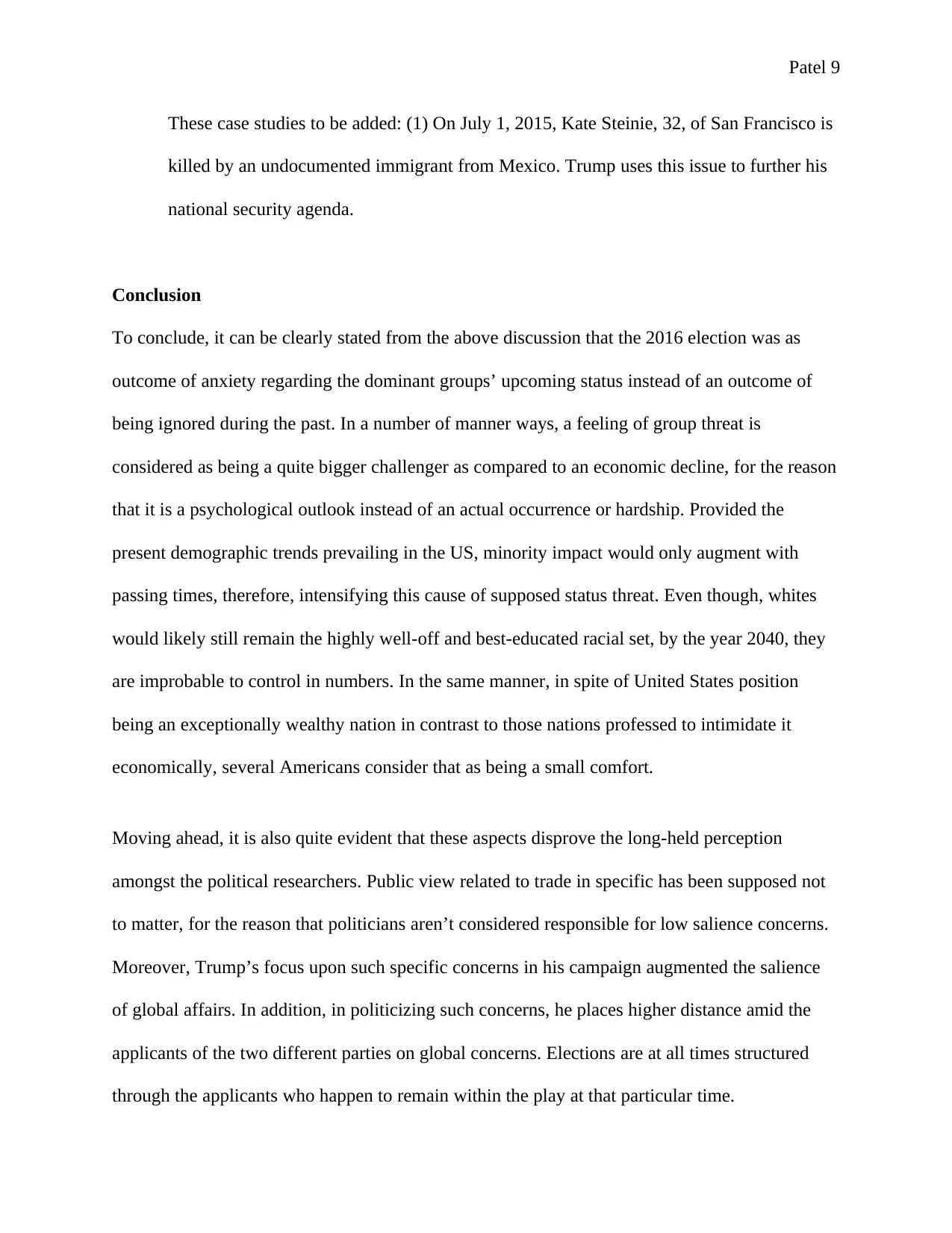
Patel 9
These case studies to be added: (1) On July 1, 2015, Kate Steinie, 32, of San Francisco is
killed by an undocumented immigrant from Mexico. Trump uses this issue to further his
national security agenda.
Conclusion
To conclude, it can be clearly stated from the above discussion that the 2016 election was as
outcome of anxiety regarding the dominant groups’ upcoming status instead of an outcome of
being ignored during the past. In a number of manner ways, a feeling of group threat is
considered as being a quite bigger challenger as compared to an economic decline, for the reason
that it is a psychological outlook instead of an actual occurrence or hardship. Provided the
present demographic trends prevailing in the US, minority impact would only augment with
passing times, therefore, intensifying this cause of supposed status threat. Even though, whites
would likely still remain the highly well-off and best-educated racial set, by the year 2040, they
are improbable to control in numbers. In the same manner, in spite of United States position
being an exceptionally wealthy nation in contrast to those nations professed to intimidate it
economically, several Americans consider that as being a small comfort.
Moving ahead, it is also quite evident that these aspects disprove the long-held perception
amongst the political researchers. Public view related to trade in specific has been supposed not
to matter, for the reason that politicians aren’t considered responsible for low salience concerns.
Moreover, Trump’s focus upon such specific concerns in his campaign augmented the salience
of global affairs. In addition, in politicizing such concerns, he places higher distance amid the
applicants of the two different parties on global concerns. Elections are at all times structured
through the applicants who happen to remain within the play at that particular time.
These case studies to be added: (1) On July 1, 2015, Kate Steinie, 32, of San Francisco is
killed by an undocumented immigrant from Mexico. Trump uses this issue to further his
national security agenda.
Conclusion
To conclude, it can be clearly stated from the above discussion that the 2016 election was as
outcome of anxiety regarding the dominant groups’ upcoming status instead of an outcome of
being ignored during the past. In a number of manner ways, a feeling of group threat is
considered as being a quite bigger challenger as compared to an economic decline, for the reason
that it is a psychological outlook instead of an actual occurrence or hardship. Provided the
present demographic trends prevailing in the US, minority impact would only augment with
passing times, therefore, intensifying this cause of supposed status threat. Even though, whites
would likely still remain the highly well-off and best-educated racial set, by the year 2040, they
are improbable to control in numbers. In the same manner, in spite of United States position
being an exceptionally wealthy nation in contrast to those nations professed to intimidate it
economically, several Americans consider that as being a small comfort.
Moving ahead, it is also quite evident that these aspects disprove the long-held perception
amongst the political researchers. Public view related to trade in specific has been supposed not
to matter, for the reason that politicians aren’t considered responsible for low salience concerns.
Moreover, Trump’s focus upon such specific concerns in his campaign augmented the salience
of global affairs. In addition, in politicizing such concerns, he places higher distance amid the
applicants of the two different parties on global concerns. Elections are at all times structured
through the applicants who happen to remain within the play at that particular time.
⊘ This is a preview!⊘
Do you want full access?
Subscribe today to unlock all pages.

Trusted by 1+ million students worldwide
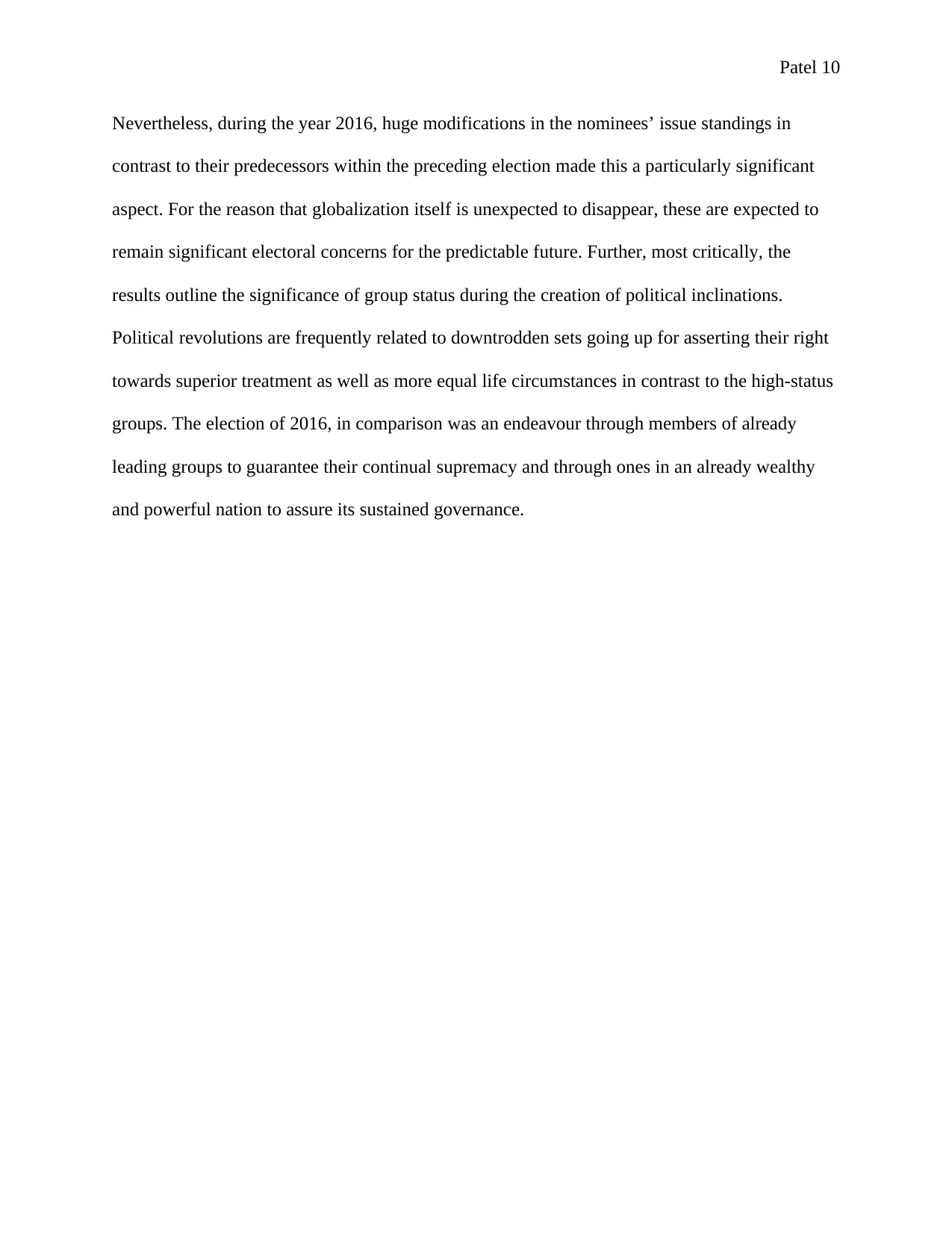
Patel 10
Nevertheless, during the year 2016, huge modifications in the nominees’ issue standings in
contrast to their predecessors within the preceding election made this a particularly significant
aspect. For the reason that globalization itself is unexpected to disappear, these are expected to
remain significant electoral concerns for the predictable future. Further, most critically, the
results outline the significance of group status during the creation of political inclinations.
Political revolutions are frequently related to downtrodden sets going up for asserting their right
towards superior treatment as well as more equal life circumstances in contrast to the high-status
groups. The election of 2016, in comparison was an endeavour through members of already
leading groups to guarantee their continual supremacy and through ones in an already wealthy
and powerful nation to assure its sustained governance.
Nevertheless, during the year 2016, huge modifications in the nominees’ issue standings in
contrast to their predecessors within the preceding election made this a particularly significant
aspect. For the reason that globalization itself is unexpected to disappear, these are expected to
remain significant electoral concerns for the predictable future. Further, most critically, the
results outline the significance of group status during the creation of political inclinations.
Political revolutions are frequently related to downtrodden sets going up for asserting their right
towards superior treatment as well as more equal life circumstances in contrast to the high-status
groups. The election of 2016, in comparison was an endeavour through members of already
leading groups to guarantee their continual supremacy and through ones in an already wealthy
and powerful nation to assure its sustained governance.
Paraphrase This Document
Need a fresh take? Get an instant paraphrase of this document with our AI Paraphraser
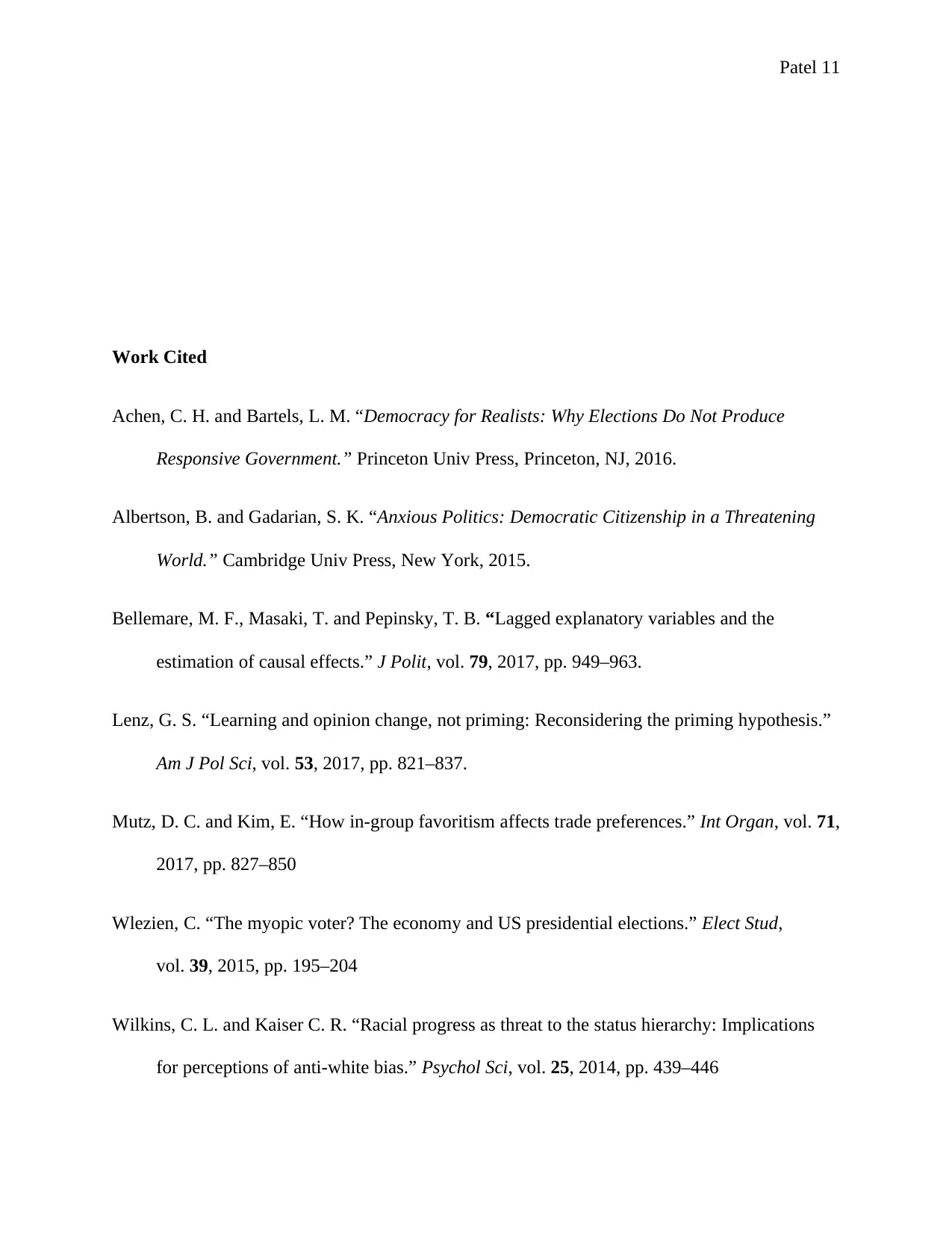
Patel 11
Work Cited
Achen, C. H. and Bartels, L. M. “Democracy for Realists: Why Elections Do Not Produce
Responsive Government.” Princeton Univ Press, Princeton, NJ, 2016.
Albertson, B. and Gadarian, S. K. “Anxious Politics: Democratic Citizenship in a Threatening
World.” Cambridge Univ Press, New York, 2015.
Bellemare, M. F., Masaki, T. and Pepinsky, T. B. “Lagged explanatory variables and the
estimation of causal effects.” J Polit, vol. 79, 2017, pp. 949–963.
Lenz, G. S. “Learning and opinion change, not priming: Reconsidering the priming hypothesis.”
Am J Pol Sci, vol. 53, 2017, pp. 821–837.
Mutz, D. C. and Kim, E. “How in-group favoritism affects trade preferences.” Int Organ, vol. 71,
2017, pp. 827–850
Wlezien, C. “The myopic voter? The economy and US presidential elections.” Elect Stud,
vol. 39, 2015, pp. 195–204
Wilkins, C. L. and Kaiser C. R. “Racial progress as threat to the status hierarchy: Implications
for perceptions of anti-white bias.” Psychol Sci, vol. 25, 2014, pp. 439–446
Work Cited
Achen, C. H. and Bartels, L. M. “Democracy for Realists: Why Elections Do Not Produce
Responsive Government.” Princeton Univ Press, Princeton, NJ, 2016.
Albertson, B. and Gadarian, S. K. “Anxious Politics: Democratic Citizenship in a Threatening
World.” Cambridge Univ Press, New York, 2015.
Bellemare, M. F., Masaki, T. and Pepinsky, T. B. “Lagged explanatory variables and the
estimation of causal effects.” J Polit, vol. 79, 2017, pp. 949–963.
Lenz, G. S. “Learning and opinion change, not priming: Reconsidering the priming hypothesis.”
Am J Pol Sci, vol. 53, 2017, pp. 821–837.
Mutz, D. C. and Kim, E. “How in-group favoritism affects trade preferences.” Int Organ, vol. 71,
2017, pp. 827–850
Wlezien, C. “The myopic voter? The economy and US presidential elections.” Elect Stud,
vol. 39, 2015, pp. 195–204
Wilkins, C. L. and Kaiser C. R. “Racial progress as threat to the status hierarchy: Implications
for perceptions of anti-white bias.” Psychol Sci, vol. 25, 2014, pp. 439–446
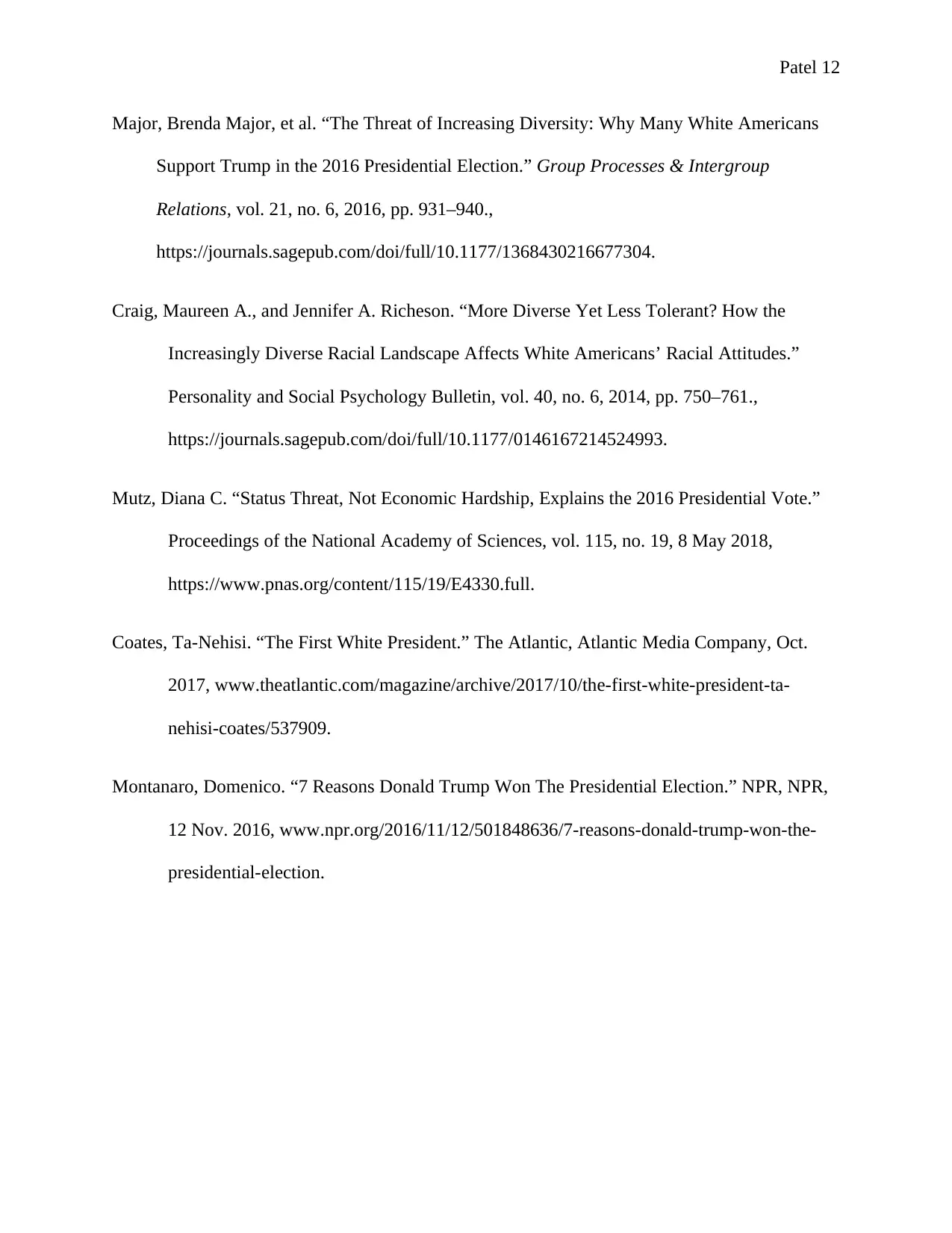
Patel 12
Major, Brenda Major, et al. “The Threat of Increasing Diversity: Why Many White Americans
Support Trump in the 2016 Presidential Election.” Group Processes & Intergroup
Relations, vol. 21, no. 6, 2016, pp. 931–940.,
https://journals.sagepub.com/doi/full/10.1177/1368430216677304.
Craig, Maureen A., and Jennifer A. Richeson. “More Diverse Yet Less Tolerant? How the
Increasingly Diverse Racial Landscape Affects White Americans’ Racial Attitudes.”
Personality and Social Psychology Bulletin, vol. 40, no. 6, 2014, pp. 750–761.,
https://journals.sagepub.com/doi/full/10.1177/0146167214524993.
Mutz, Diana C. “Status Threat, Not Economic Hardship, Explains the 2016 Presidential Vote.”
Proceedings of the National Academy of Sciences, vol. 115, no. 19, 8 May 2018,
https://www.pnas.org/content/115/19/E4330.full.
Coates, Ta-Nehisi. “The First White President.” The Atlantic, Atlantic Media Company, Oct.
2017, www.theatlantic.com/magazine/archive/2017/10/the-first-white-president-ta-
nehisi-coates/537909.
Montanaro, Domenico. “7 Reasons Donald Trump Won The Presidential Election.” NPR, NPR,
12 Nov. 2016, www.npr.org/2016/11/12/501848636/7-reasons-donald-trump-won-the-
presidential-election.
Major, Brenda Major, et al. “The Threat of Increasing Diversity: Why Many White Americans
Support Trump in the 2016 Presidential Election.” Group Processes & Intergroup
Relations, vol. 21, no. 6, 2016, pp. 931–940.,
https://journals.sagepub.com/doi/full/10.1177/1368430216677304.
Craig, Maureen A., and Jennifer A. Richeson. “More Diverse Yet Less Tolerant? How the
Increasingly Diverse Racial Landscape Affects White Americans’ Racial Attitudes.”
Personality and Social Psychology Bulletin, vol. 40, no. 6, 2014, pp. 750–761.,
https://journals.sagepub.com/doi/full/10.1177/0146167214524993.
Mutz, Diana C. “Status Threat, Not Economic Hardship, Explains the 2016 Presidential Vote.”
Proceedings of the National Academy of Sciences, vol. 115, no. 19, 8 May 2018,
https://www.pnas.org/content/115/19/E4330.full.
Coates, Ta-Nehisi. “The First White President.” The Atlantic, Atlantic Media Company, Oct.
2017, www.theatlantic.com/magazine/archive/2017/10/the-first-white-president-ta-
nehisi-coates/537909.
Montanaro, Domenico. “7 Reasons Donald Trump Won The Presidential Election.” NPR, NPR,
12 Nov. 2016, www.npr.org/2016/11/12/501848636/7-reasons-donald-trump-won-the-
presidential-election.
⊘ This is a preview!⊘
Do you want full access?
Subscribe today to unlock all pages.

Trusted by 1+ million students worldwide
1 out of 12
Related Documents
Your All-in-One AI-Powered Toolkit for Academic Success.
+13062052269
info@desklib.com
Available 24*7 on WhatsApp / Email
![[object Object]](/_next/static/media/star-bottom.7253800d.svg)
Unlock your academic potential
Copyright © 2020–2025 A2Z Services. All Rights Reserved. Developed and managed by ZUCOL.




